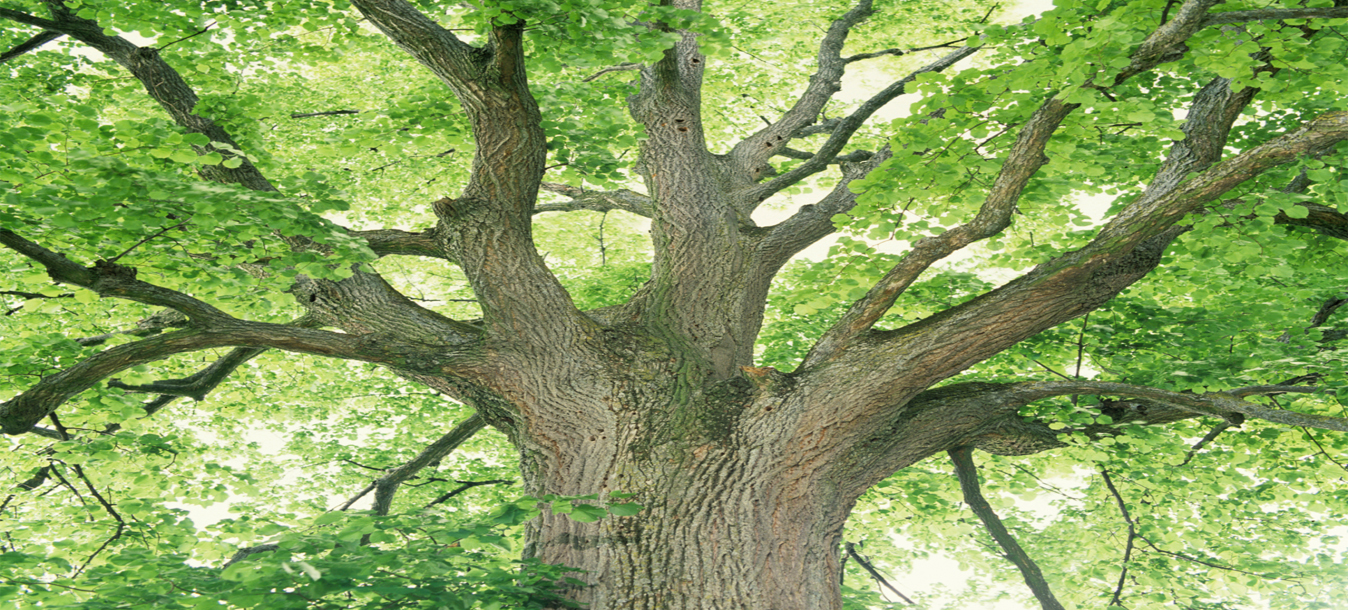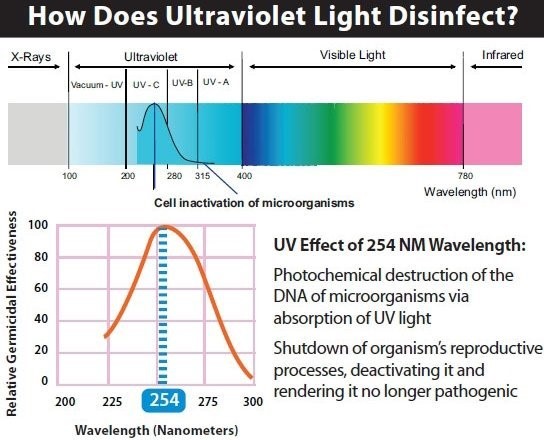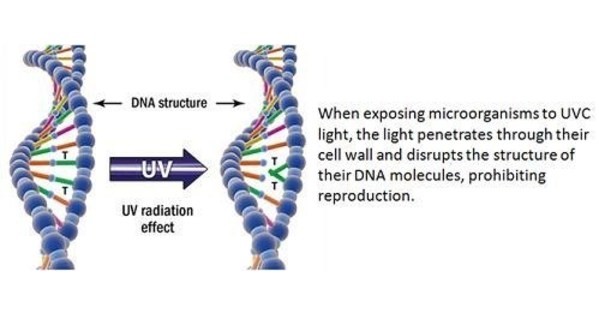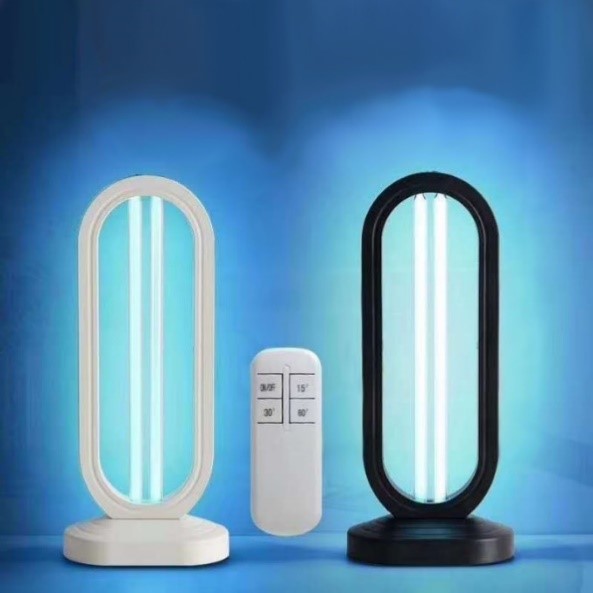UVC lights in the application of UVGI for the purpose of reducing the risks of contracting COVID-19
-
What is Ultraviolet (UV) Light?
Ultraviolet (UV) is electromagnetic radiation with wavelength from 10 nm to 400 nm, shorter than that of visible light but longer than X-rays. UV radiation is present in sunlight, and constitutes about 10% of the total electromagnetic radiation output from the Sun. It is also produced by electric arcs and specialized lights, such as mercury-vapor lamps, tanning lamps, and black lights. Although long-wavelength ultraviolet is not considered an ionizing radiation because its photons lack the energy to ionize atoms, it can cause chemical reactions and causes many substances to glow or fluoresce. Consequently, the chemical and biological effects of UV are greater than simple heating effects, and many practical applications of UV radiation derive from its interactions with organic molecules. Sunlight contains three types of UV.
First there is UVA (315-400nm), which makes up the vast majority of the ultraviolet radiation reaching the Earth’s surface. It’s capable of penetrating deep into the skin and is thought to be responsible for up to 80% of skin ageing, from wrinkles to age spots.
Next there’s UVB (280-315nm), which can damage the DNA in our skin, leading to sunburn and eventually skin cancer (recently scientists have discovered that UVA can also do this). Both are reasonably well known, and can be blocked out by most good sun creams.
-
What is UVC Light?
There is also a third type: UVC (100-280nm). This relatively obscure part of the spectrum consists of a shorter, more energetic wavelength of light. It is particularly good at destroying genetic material – whether in humans or viral particles. Luckily, most of us are unlikely to have ever encountered any because it’s filtered out by ozone in the atmosphere long before it reaches the Earth’s surface.
-
What is UVGI?
Ultraviolet germicidal irradiation (UVGI) is a disinfection method that uses short-wavelength ultraviolet (ultraviolet C or UVC), light to kill or inactivate microorganisms by destroying nucleic acids and disrupting their DNA, leaving them unable to perform vital cellular functions like duplication. UVGI is used in a variety of applications, such as food, air, and water purification.
UVGI devices can produce strong enough UVC light in circulating air or water systems to make them inhospitable environments to microorganisms and pathogens such as bacteria, viruses, moulds, fungi, protozoans and parasites. UVGI is often coupled with a filtration system to effectively sanitize air and water and can be used independently to disinfect surfaces, air and water with the correct application and conditions.
The application of UVGI for disinfection has been an accepted practice since the mid-20th century. It has been used primarily in medical sanitation and sterile work facilities. Increasingly, it has been employed to sterilize drinking and wastewater, as the holding facilities are enclosed and can be circulated to ensure a higher exposure to the UV.
Since the finding in 1878, artificially produced UVC has become a staple method of sterilisation – one used in hospitals, airplanes, offices, and factories every day.
Though there hasn’t been any research looking at how UVC affects SARS-nCoV-2 specifically, studies have shown that it can be used effectively against other corona viruses, such as SARS-CoV-1 by warping the structure of their genetic material and preventing the viral particles from replicating.
As a result, a concentrated form of UVC is now on the front line in the fight against Covid-19. In China, whole buses are being lit up by UV light each night, while UVC-emitting robots have been cleaning floors in hospitals. Banks have even been using the light to disinfect their money.
-
What are short-wave ultraviolet MV lamps?
Shortwave UV lamps are made using a fluorescent lamp tube with no internal phosphor coating, composed of fused quartz or specialised borosilicate glass such as Vycor, since standard borosilicate or ordinary soda-lime glass blocks UVC. These lamps emit ultraviolet light with two peaks in the UVC band at 253.7 nm (85-90%) and 185 nm (5-10% due to the mercury within the lamp), as well as some visible light (<5% of total light emitted). Doped fused quartz tubes pass the 253.7 nm radiation but blocks the 185 nm wavelength. These low-pressure MV lamps have a typical efficiency of ~30–40%, meaning that for every 100 watts of electricity required to operate, they will produce approximately 30–40 watts of total UV output. They also emit bluish-white visible light, due to mercury’s other spectral lines. These “germicidal” lamps are used extensively for disinfection of surfaces in laboratories, food-processing industries, and for disinfecting water supplies.
According Alex Berezow, a microbiologist who has written on the topic, “UV light is lethal to bacteria and viruses because of its high frequency that scrambles and damages their nuclear material. When it damages the DNA (or RNA) code of these pathogens, it also triggers lethal mutations that prevent them from reproducing properly.” While experts say there haven’t been conclusive tests showing that UV light can kill the coronavirus yet, Berezow says “UV light kills everything: bacteria, fungi, viruses. It should kill coronavirus.” What we do know for sure is that it is effective against other viruses like the flu and SARS. As we all try to protect ourselves from unnecessary coronavirus exposure, it appears HIGHLY PROBABLE that this technology KILLS or at least reduces the efficacy of SARS-nCoV-2 substantially.
-
Effectiveness:
-
UV Dose:
-
Every pathogen requires a specific UV Dose to render it ineffective. If the dose is insufficient, not all pathogens will be “destroyed”. For the purpose of stand-alone UVGI disinfection effectiveness offered by ecoLED UVGI lamps we will only look at the calculation for static air and surface disinfection and exclude liquid and ventilation system calculations. In this application the UV effectiveness is estimated by calculating the UV dose which will be delivered to the microbial population.
-
UV Dose Calculation:
UV dose μWs/cm2 = UV intensity μW/cm2 × exposure time (secs) or D=I(@1m) x T(s)
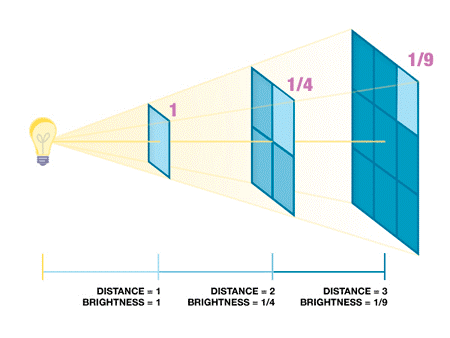 The UV intensity is specified for each lamp at a distance of 1 meter. UV intensity is inversely proportional to the square of the distance so it decreases exponentially at longer distances. Also, to ensure effectiveness the UV dose must be calculated at the end of lamp life (usually 80% of its initial UV output) and at the furthest distance from the lamp on the periphery of the target area. Some lamps are coated with a fluorated ethylene polymer to contain glass shards and mercury in case of breakage, which may reduce UV output by up to 20%. Thus, to accurately predict what UV dose will be delivered to the target, the UV intensity (adjusted for distance, coating and end of lamp life), must be multiplied by the exposure time. In static applications the exposure time can be as long as needed for an effective UV dose to be reached.
The UV intensity is specified for each lamp at a distance of 1 meter. UV intensity is inversely proportional to the square of the distance so it decreases exponentially at longer distances. Also, to ensure effectiveness the UV dose must be calculated at the end of lamp life (usually 80% of its initial UV output) and at the furthest distance from the lamp on the periphery of the target area. Some lamps are coated with a fluorated ethylene polymer to contain glass shards and mercury in case of breakage, which may reduce UV output by up to 20%. Thus, to accurately predict what UV dose will be delivered to the target, the UV intensity (adjusted for distance, coating and end of lamp life), must be multiplied by the exposure time. In static applications the exposure time can be as long as needed for an effective UV dose to be reached.
.: Exposure time required(sec) (RTs) = UV dose required (RD)/ UV intensity (I) – (20% to 40% for adjustments) x distance in m2 from light source or RTs = RD/I x m2
ecoLED therefore includes a broad-spectrum pathogen dosage recommendation (converted into recommended operating time for relative room size, assuming the light is placed in the centre of the room) on all packaging. These recommended times are based on effective eradication of the most resilient pathogens and err in the favour over dosage to ensure the best eradication results.
-
Limitations:
- Line of Sight Irradiation:
 Although reflected UVC light is effective, it is much less effective than direct light in terms of the dosage calculation. The light source needs to be placed in a position to have direct line of sight of as many critical surfaces as possible and a metallic surface to best reflect the light onto areas of shadow for best results. Moving or repositioning the lamp could also be an alternative to eliminate and illuminate blind spots. This is where UVC (below 240nm) created Ozone assists in disinfection by reaching the areas out of line of site of UVC light and hence its own destruction by UVC over 240nm, but the benefits fall short of the human dangers of Ozone and hence the necessity for post light use Ozone rich air removal or lengthy post light use dissipation waiting time prior to human exposure of the sanitised area.
Although reflected UVC light is effective, it is much less effective than direct light in terms of the dosage calculation. The light source needs to be placed in a position to have direct line of sight of as many critical surfaces as possible and a metallic surface to best reflect the light onto areas of shadow for best results. Moving or repositioning the lamp could also be an alternative to eliminate and illuminate blind spots. This is where UVC (below 240nm) created Ozone assists in disinfection by reaching the areas out of line of site of UVC light and hence its own destruction by UVC over 240nm, but the benefits fall short of the human dangers of Ozone and hence the necessity for post light use Ozone rich air removal or lengthy post light use dissipation waiting time prior to human exposure of the sanitised area.
- Normal or tempered soda-lime glass windows or tables shield UVC, limiting the harmful effect on humans or other living organisms, even though you can see the visible blue wavelength of these lights emitted through these objects. Similarly, any area shielded by glass may not be subjected to UVC and hence the germicidal effect of the light will be limited to the reflected light cast in that area only.
- Disinfection takes time, ranging from 15 min to 60 min depending on room size. At no time during this process of sterilization should any human be present in this room or environment.
-
Safety:
- UVC is dangerous to the human eye. Lights therefore should be switched on and off remotely or using a timer. Ensuring that the light is on, should not be done by looking into the light for ANY length of time but rather by observing the change in the illumination of an environment by the light reflected off walls or other less reflective surfaces from a remote location.
- In most UVGI systems the lamps are shielded or are in environments that limit exposure, such as a closed water tank or closed air circulation system, often with interlocks that automatically shut off the UV lamps if the system is opened for access by humans. The lamps we intend supplying to the SA market have timers and remote controls to be able to turn the units on and off thus making it possible to operate these without ANY light exposure.
- UVC radiation is able to break down some chemical bonds. Over time this leads to increased aging of plastics, paints and other materials. When UV is used NEAR plastic, rubber, or insulation, care should be taken to shield these items; metal tape or aluminium foil will suffice.
-
Dangers:
-
UVC Light
- For human beings, skin exposure to germicidal wavelengths of UV light can produce sunburn and skin cancer. The World Health Organization (WHO) has issued a warning against people using UV light to sterilise their hands or any other part of their skin.
- Exposure of the eyes to this UV radiation can produce extremely painful inflammation of the cornea, retina damage and temporary
 or permanent vision impairment, up to and including blindness. The American Conference of Governmental Industrial Hygienists (ACGIH) Committee on Physical Agents has established a threshold limit value (TLV) for UVC exposure to avoid such skin and eye injuries among those most susceptible. For 254 nm UV, this TLV is 6 µJ/cm2 over an eight-hour period, which was extrapolated to an irradiance of 0.2 μW/cm2, widely interpreted as the upper permissible limit of irradiance at eye height. This TLV is used in setting lamp safety standards by the Illuminating Engineering Society of North America. We are recommending no direct eye contact with this product ever, but accidental short exposure should have no noticeable effect providing exposure to the eye is below the above irradiance guidelines.
or permanent vision impairment, up to and including blindness. The American Conference of Governmental Industrial Hygienists (ACGIH) Committee on Physical Agents has established a threshold limit value (TLV) for UVC exposure to avoid such skin and eye injuries among those most susceptible. For 254 nm UV, this TLV is 6 µJ/cm2 over an eight-hour period, which was extrapolated to an irradiance of 0.2 μW/cm2, widely interpreted as the upper permissible limit of irradiance at eye height. This TLV is used in setting lamp safety standards by the Illuminating Engineering Society of North America. We are recommending no direct eye contact with this product ever, but accidental short exposure should have no noticeable effect providing exposure to the eye is below the above irradiance guidelines. - The above dangers also apply to animals and UVC may be harmful to plants.
-
UVC created Ozone
- When light of wavelength 100-240nm passes through air it disrupts the oxygen molecules (O2) creating valent oxygen atoms that re attach themselves to other oxygen molecules individually forming Ozone (O3) in a process called photolysis. Because this new “unstable oxygen molecule” (Ozone) can react with and break down most things it comes in contact with, it makes this chemical very effective for removing odours and killing mould and mildew. This would be safe if the Ozone disappeared just like the UVC when the light was turned off, but it doesn’t, it remains in the air until extracted or it has completely reacted with other molecules and VOC’s. The same volatility that makes it effective as a steriliser makes it harmful to humans and animals in elevated concentrations which is documented to cause short- and long-term skin, eye, and lung damage, just like petrol or paint. It just smells better. The US Environmental Protection Agency designated 0.05 parts per million (ppm) of ozone to be a safe level. Many UVC lamp manufacturers promote Ozone producing lamps way in excess of this limit but fail to acknowledge the dangers of use in uncontrolled environments. As ecoLED lamps are targeted for unprofessional and domestic users that may not have adequate ventilation systems and measuring devises to determine safe levels after use, we do not recommend lamps producing Ozone. We only market UVC lamps that have been doped to block all Ozone producing UV light below 254nm wavelength.
-
- ecoLED includes an operating instruction leaflet with each product to inform users of proper and safe use prior to operation. Please read before use!
-
Table of required doses of UVC
- The following table provides approximate UVC dosages required to render these 90% (log 1) or 99.99% (log 4) inactive. Many studies have been conducted on Corona viruses including MERS and SARS and UVGI has proven to be highly effective in their eradication. See http://www.iuva.org/COVID-19 for test results and references.
| Organisms: | Energy dosage of Ultraviolet radiation in µW/cm2needed for kill factor | |
| Bacteria | 90% | 99.99% |
| Bacillus anthracis – Anthrax | 4,520 | 8,700 |
| Bacillus anthracis spores – Anthrax spores | 24,320 | 46,200 |
| Bacillus magaterium sp. (spores) | 2,730 | 5,200 |
| Bacillus magaterium sp. (veg.) | 1,300 | 2,500 |
| Bacillus paratyphusus | 3,200 | 6,100 |
| Bacillus subtilis spores | 11,600 | 22,000 |
| Bacillus subtilis | 5,800 | 11,000 |
| Clostridium tetani | 13,000 | 22,000 |
| Corynebacterium diphtheriae | 3,370 | 6,510 |
| Ebertelia typhosa | 2,140 | 4,100 |
| Escherichia coli (E.Coli) | 3,000 | 6,600 |
| Leptospiracanicola – infectious Jaundice | 3,150 | 6,000 |
| Microccocus candidus | 6,050 | 12,300 |
| Microccocus sphaeroides | 1,000 | 15,400 |
| Mycobacterium tuberculosis | 6,200 | 10,000 |
| Neisseria catarrhalis | 4,400 | 8,500 |
| Phytomonas tumefaciens | 4,400 | 8,000 |
| Proteus vulgaris | 3,000 | 6,600 |
| Pseudomonas aeruginosa | 5,500 | 10,500 |
| Pseudomonas fluorescens | 3,500 | 6,600 |
| Salmonella enteritidis | 4,000 | 7,600 |
| Salmonela paratyphi – Enteric fever | 3,200 | 6,100 |
| Salmonella typhosa – Typhoid fever | 2,150 | 4,100 |
| Salmonella typhimurium | 8,000 | 15,200 |
| Sarcina lutea | 19,700 | 26,400 |
| Serratia marcescens | 2,420 | 6,160 |
| Shigella dyseteriae – Dysentery | 2,200 | 4,200 |
| Shigella flexneri – Dysentery | 1,700 | 3,400 |
| Shigella paradysenteriae | 1,680 | 3,400 |
| Spirillum rubrum | 4,400 | 6,160 |
| Staphylococcus albus | 1,840 | 5,720 |
| Staphylococcus aerius | 2,600 | 6,600 |
| Staphylococcus hemolyticus | 2,160 | 5,500 |
| Staphylococcus lactis | 6,150 | 8,800 |
| Streptococcus viridans | 2,000 | 3,800 |
| Vibrio comma – Cholera | 3,375 | 6,500 |
| Moulds | 90% | 100% |
| Aspergillius flavus | 60,000 | 99,000 |
| Aspergillius glaucus | 44,000 | 88,000 |
| Aspergillius niger | 132,000 | 330,000 |
| Mucor racemosus A | 17,000 | 35,200 |
| Mucor racemosus B | 17,000 | 35,200 |
| Oospora lactis | 5,000 | 11,000 |
| Penicillium expansum | 13,000 | 22,000 |
| Penicillium roqueforti | 13,000 | 26,400 |
| Penicillium digitatum | 44,000 | 88,000 |
| Rhisopus nigricans | 111,000 | 220,000 |
| Protozoa | 90% | 100% |
| Chlorella Vulgaris | 13,000 | 22,000 |
| Nematode Eggs | 45,000 | 92,000 |
| Paramecium | 11,000 | 20,000 |
| Virus | 90% | 100% |
| Bacteriopfage – E. Coli | 2,600 | 6,600 |
| Infectious Hepatitis | 5,800 | 8,000 |
| Influenza | 3,400 | 6,600 |
| Poliovirus – Poliomyelitis | 3,150 | 6,600 |
| Tobacco mosaic | 240,000 | 440,000 |
| Yeast | 90% | 100% |
| Brewers yeast | 3,300 | 6,600 |
| Common yeast cake | 6,000 | 13,200 |
| Saccharomyces carevisiae | 6,000 | 13,200 |
| Saccharomyces ellipsoideus | 6,000 | 13,200 |
| Saccharomyces spores | 8,000 | 17,600 |
-
Why is ecoLED favouring Mercury Vapour over LED?
UVC LEDs are beginning to be used in disinfection known as germicidal lamps. UVC LEDs use semiconductors to emit light between 255 nm-280 nm. The wavelength emission is tuneable by adjusting the material of the semiconductor. As of 2019, the electrical-to-UVC conversion efficiency of LEDs was lower than that of mercury lamps and the longevity was no better so therefore ecoLED prefers to use mercury lamps until this LED technology is improved. There is also reported falsification of wavelength photometric reports by LED manufactures in this time of COVID-19 for opportunistic reasons and ecoLED does not with to provide a product without verified test results.
Recently, scientists have discovered a promising new type of UVC which is less dangerous to handle, and still lethal to viruses and bacteria. Far-UVC has a shorter wavelength than regular UVC, and so far, experiments with human skin cells in the lab have shown that it doesn’t damage their DNA (more research is needed to be sure).
Table Lamp Specifications:
-
Description:
- A portable desk or hanging luminaire with UVC globe that operates on 230v 50/60Hz from a standard RSA wall socket using between 36w of electricity.
-
Features:
- Timer: 15min, 30 min, 60min (for different sized rooms and pathogens)
- Remote on / off
- Ozone: Safely non-generating (183nm filtered)
-
Applications:
- Hospital waiting rooms and public spaces that are unoccupied for 60min per day
- Doctors consulting rooms (used after hours)
- Domestic environments (used when no one is present in the space)
- Offices, receptions, workshops, store rooms (used after hours)
-
Irradiance:
- ~1600µW/cm2 @1m
-
Dimensions:
- Approximately 200 X 200 x 500mm
- Weight approximately 2.4kg
-
Anticipated recommended retail:
- R449
- Images:
T8 Tube Specifications:
-
Description:
- A T8 Mercury Vapour UVC 4ft tube globe that operates on 230v 50/60Hz in a standard T8 fluorescent fitting using 36w of electricity.
-
Features:
- Available with or without T8 fitting.
- Can be used in standard magnetic or electronic ballast T8 fluorescent fittings.
- Each globe can be used for up to 40m2.
- Timers and motion sensors can be used on these tubes for scheduled automation and safe operation.
- Tubes can be used vertically or horizontally for ceiling, mobile or wall mount applications.
- Ozone: Safely non-generating (183nm filtered). Access to the treated area can be gained immediately after the light has been switched off. No Ozone cleansing is necessary post operation.
-
Applications:
- Public spaces that are unoccupied for 60min per day, eg. hospital waiting rooms.
- Doctors consulting rooms, public waiting areas, (not used after hours).
- Retail Stores, Supermarkets, Grocery Stores, General Dealers etc.(used after closing).
- Domestic environments (used when no one is present in the space).
- Offices, receptions, workshops, store rooms (used after hours).
-
Irradiance:
- ~1600µW/cm2 @1m
-
Dimensions:
- Approximately 1223 X 45 x 35mm
- Weight approximately 400g
-
Anticipated recommended retail:
- R249
-
Images:

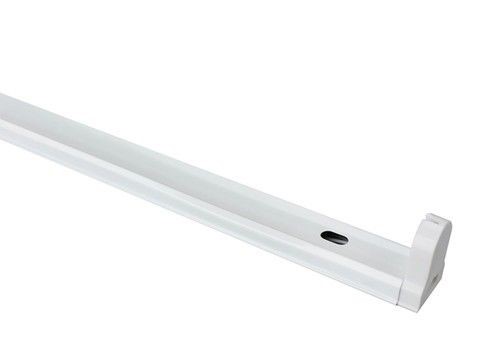

Share on Facebook
